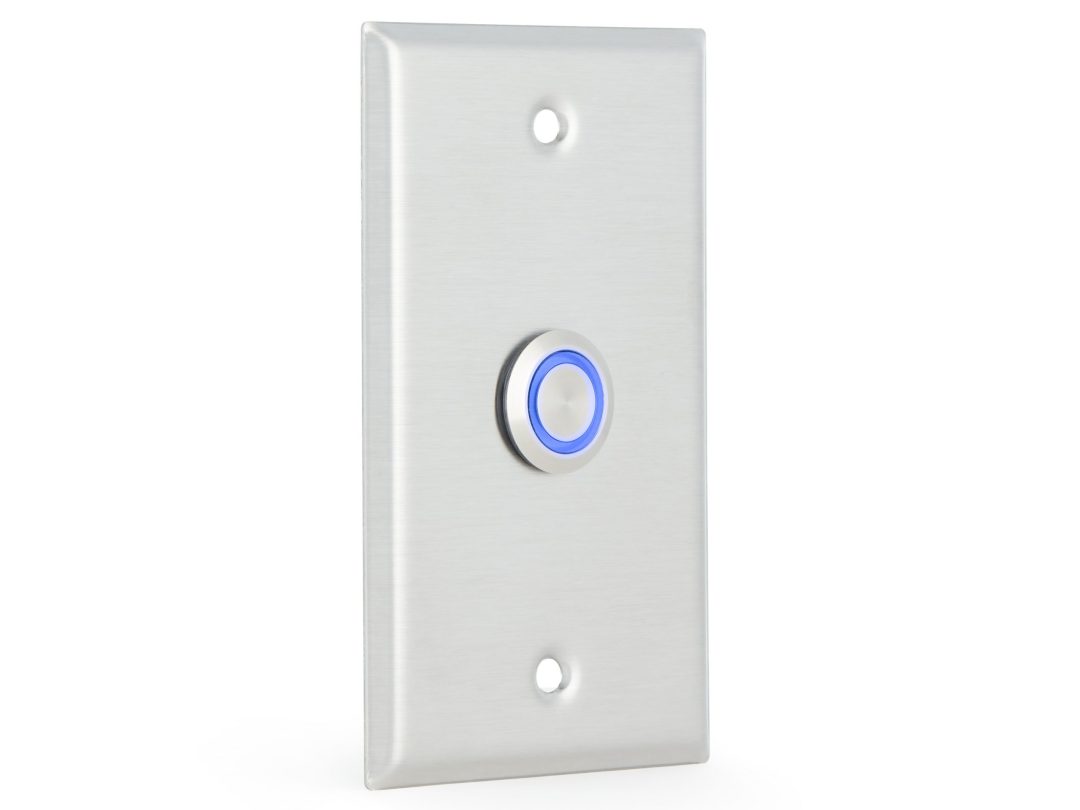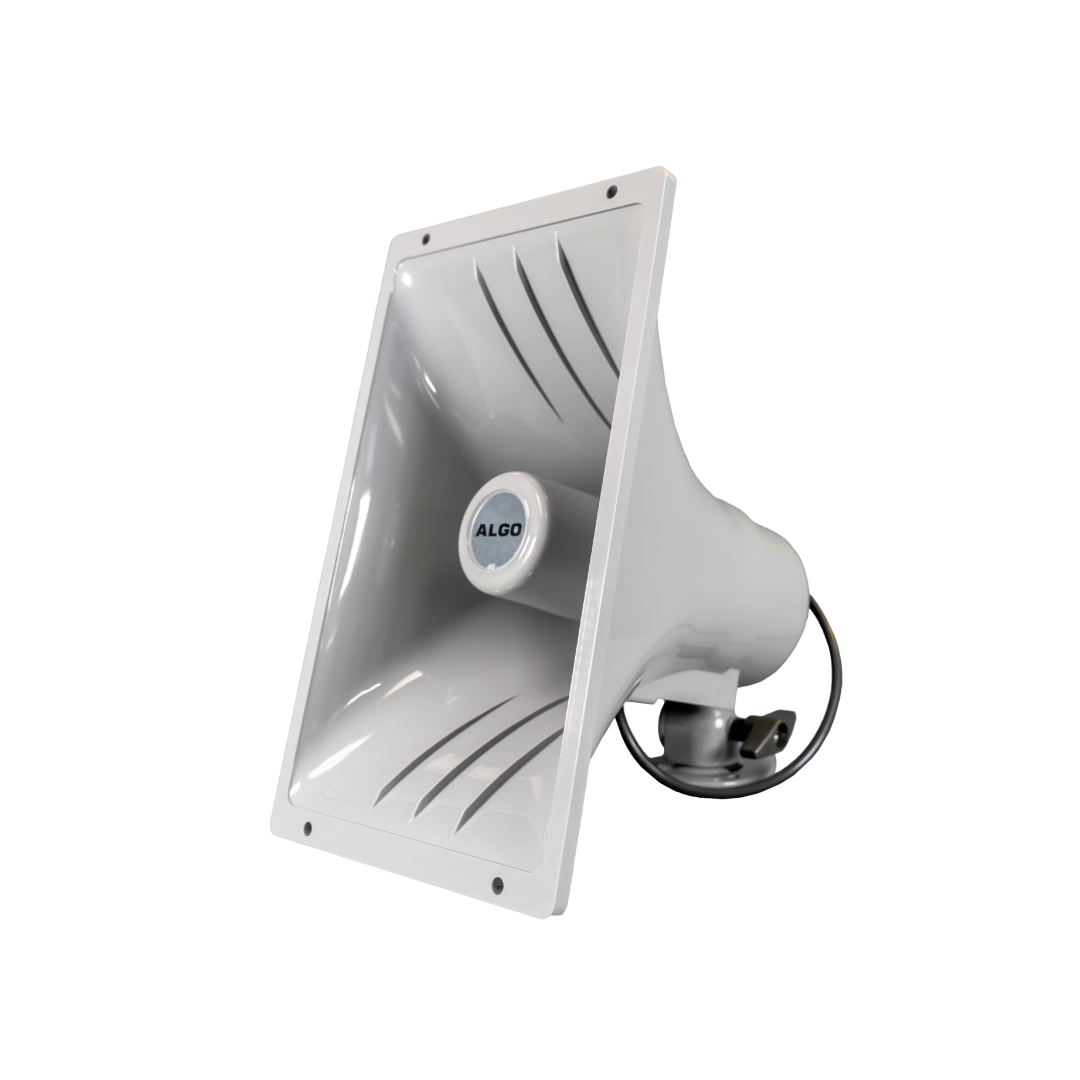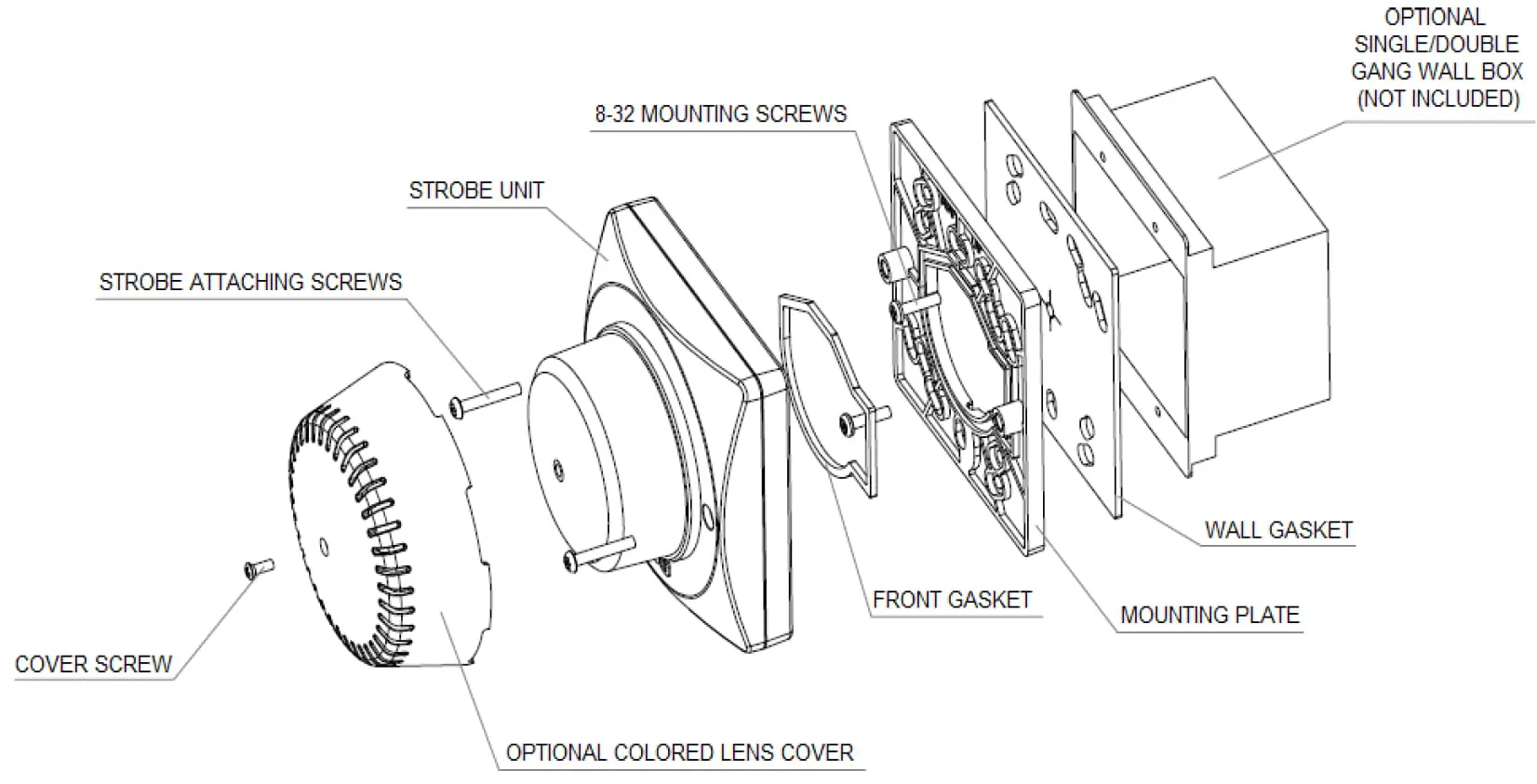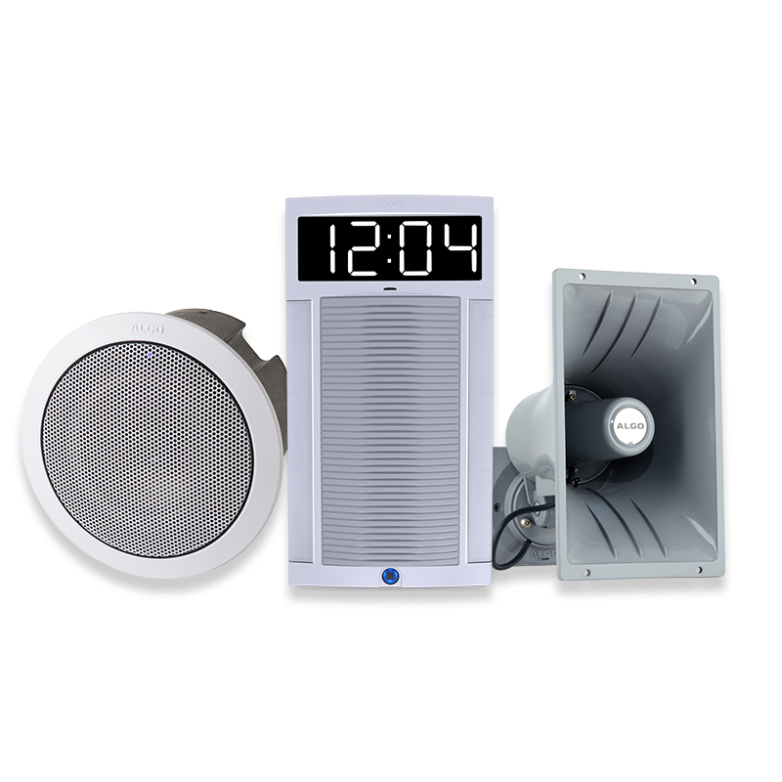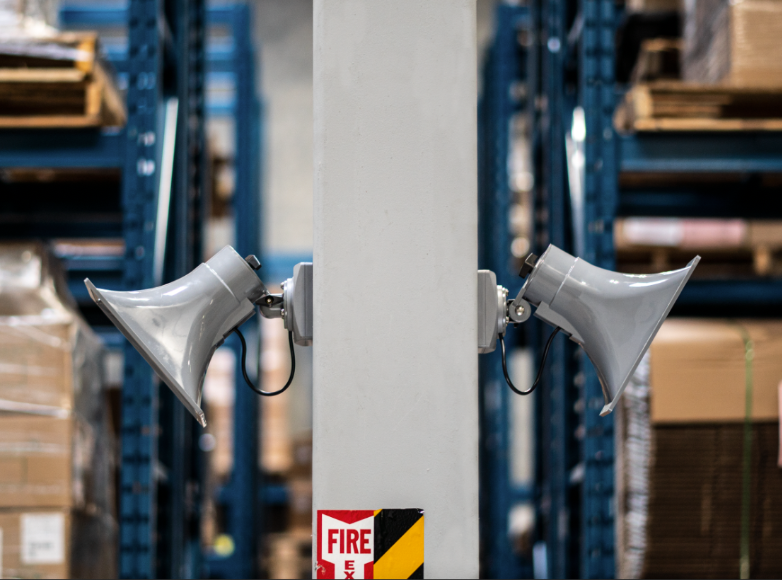Description
Wideband IP Horn Speaker
The 8186 SIP Horn Speaker supports the Wideband G.722 HD voice codec. Consequently, there is high intelligibility and clarity of audio from the speaker for IP paging of voice announcements and emergency notification. The result is better STI-PA scores, which is important in meeting standards such as NFPA 72 and NEMA SB-40 for Emergency Communication in Education.
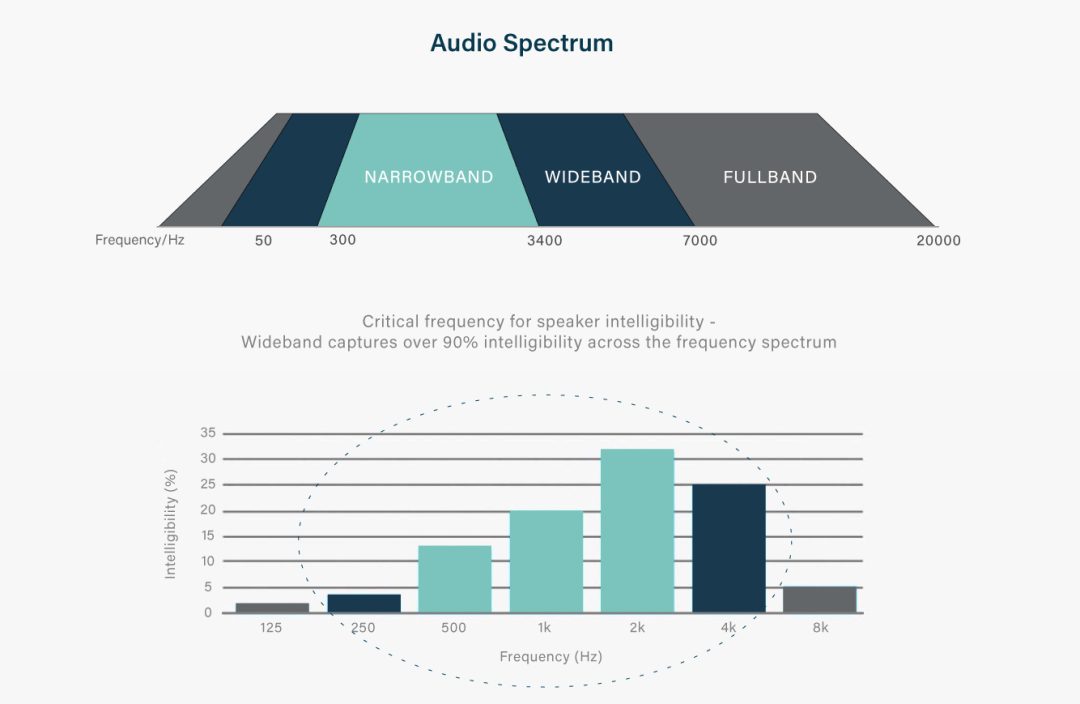
IP Loud Ringer
The Ring extension on the 8186 is used for loud ringing / night bell applications. The 8186 will play a ring tone WAV file saved in 1GB device memory when this extension is called. Typically the speaker will be configured in a ring group to include a telephone(s). The WAV file will play for the duration of the ring event until the call is answered. Several default ring tones are available in the speaker, however, custom WAV files can be uploaded to the device.
Up to 10 Ring extensions are available to register on a single speaker for this purpose, thereby allowing one speaker to act as a loud ringer for several telephones by configuring different ring groups for each registered Ring extension.
The 8186 is typically twenty times louder than a telephone speaker for loud ringing. Where audible and visual telephone ring alerting is required, the 8180 can be combined with an Algo strobe light using multicast or a relay.
Scale Algo IP Paging Speakers with Multicast
The 8186 SIP Horn Speaker supports multicast send or receive. As a result, many Algo network speakers can be deployed to cover any size building, campus (e.g., classrooms in a school, college or university) or enterprise. There is no limit to the number of devices part of a multicast, and a minimum of network traffic activity is utilized.
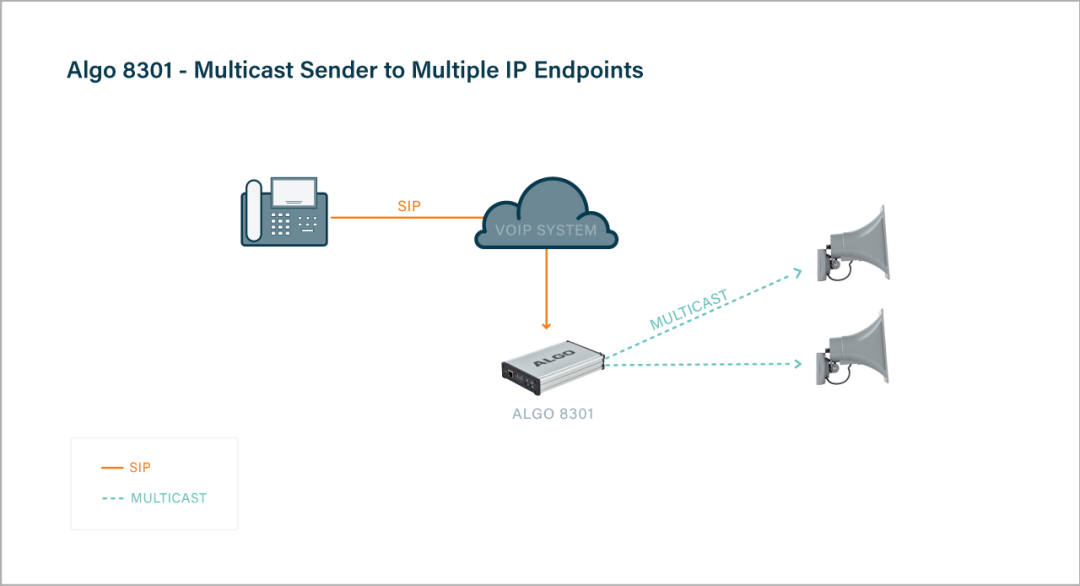
A single registered 8186 IP horn can be configured to multicast to any number and mix of Algo IP speakers, strobe lights, paging adapters, and multicast supported IP telephones.
Multicast provides cost-effective scalability using a minimum of SIP registered endpoints, as only the endpoint designated to send the multicast needs to be registered. Devices configured to receive the multicast do not need registration.
Support is available for RTP multicast, in addition to Polycom Group Page, Singlewire InformaCast (part no. 8186-IC) and Syn-Apps Revolution.
Any combination and number of Algo IP endpoints can be configured as multicast for emergency alerting to cover any size room, building, campus, or enterprise.
Using Multicast for Zone Paging
Multicast zone paging for up to 50 zones can be configured from a single 8186 horn speaker. Zones can be selected one of two ways. One option is to map multicast page zones to individual SIP extensions on the speaker. Fifty (50) page extensions are available for this purpose. Alternatively, in order to minimize SIP registrations, multicast page zones can be configured in the 8186 horn as a DTMF keypress selection using the dial pad of the telephone making the page call.
Note: Additional page zones can be configured by registering individual Algo IP speakers for specific room paging or adding more functionality (e.g. loud ringing). Speakers with SIP registrations can also be configured to be a member / receiver of multicast zones.
Dynamic Volume Control & Talkback
Speaker volume can be configured via the web GUI of the endpoint. However, the 8186 speaker’s microphone can also be used to monitor and adapt speaker volume according to background noise levels. This unique Algo feature is called Ambient Noise Compensation. Where many paging speakers are deployed in a room / building, volume can self-adjust to the background noise levels at each speaker location. Ambient Noise Compensation helps to ensure that announcements and alerts are heard but never too loud.
Talkback is supported in the 8186 horn. This feature can be enabled for a page call using the speaker’s microphone.
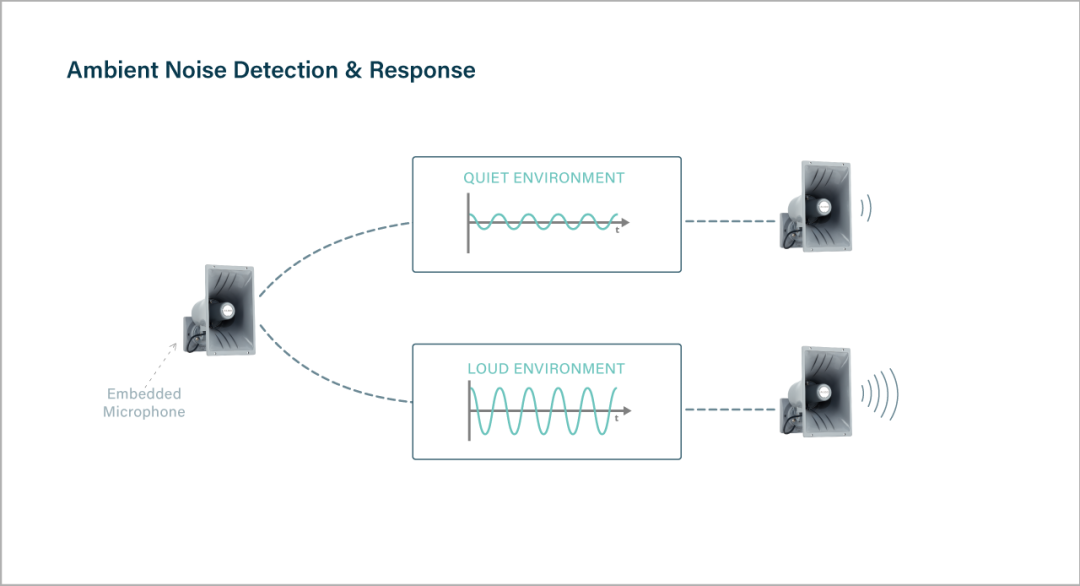
Multi-Application SIP Extensions
Multiple SIP registrations are available in this IP speaker, including Page (50), Emergency Alert (10), and Ring (10) extensions. On-Page, the speaker will auto-answer when called for making public address (PA) voice announcements. For Ring and Emergency Alert extensions the speaker will play a configurable WAV file from 1GB device memory when the extension is called (e.g., ring tones for telephone alerting, notification alerts for safety/security/emergency events, and informational announcements).
Emergency Notification Alerting
For notification alerting of safety, security, and emergency events there are two activation options available:
- Dial an Emergency Alert extension.
- Connect a button to the speaker’s relay input.
Up to 10 Emergency Alert extensions are available to register on the 8186 SIP Horn Speaker, allowing for different types of alerts to be activated when the extension is called (e.g., lockdown, evacuation, shelter, all clear, etc.). Custom WAV files can be uploaded to 1GB of device memory. A Call to Cancel feature is available to allow the emergency alert to play continuously for as long as desired until canceled. Alternatively, the WAV file alert can be configured to play for a pre-set duration. The user does not have to remain on the phone when calling the Emergency Alert extension. As soon as the call is made the Algo endpoint will play the WAV file as configured, making emergency alerting simple and efficient from any telephone or device in the UC environment. If the Call to Cancel extension is configured, the same canceling extension will apply to any of the Emergency Alert extensions registered.
As an alternative option for emergency alerting, any button or accessory providing a contact closure, including the Algo 1202 and 1203 buttons, can be wired to the 8186 relay input using a 24 gauge single twisted pair. Three configuration options are available via the speaker’s relay input upon button activation:
- Play and/or multicast an alert
- Call a target extension and play a discrete WAV
- Call a target extension and have a two-way call via the speaker’s microphone
In the diagram below, power for the Algo 1202 and 1203 buttons is provided by the available PoE from the 8186 IP horn speaker.
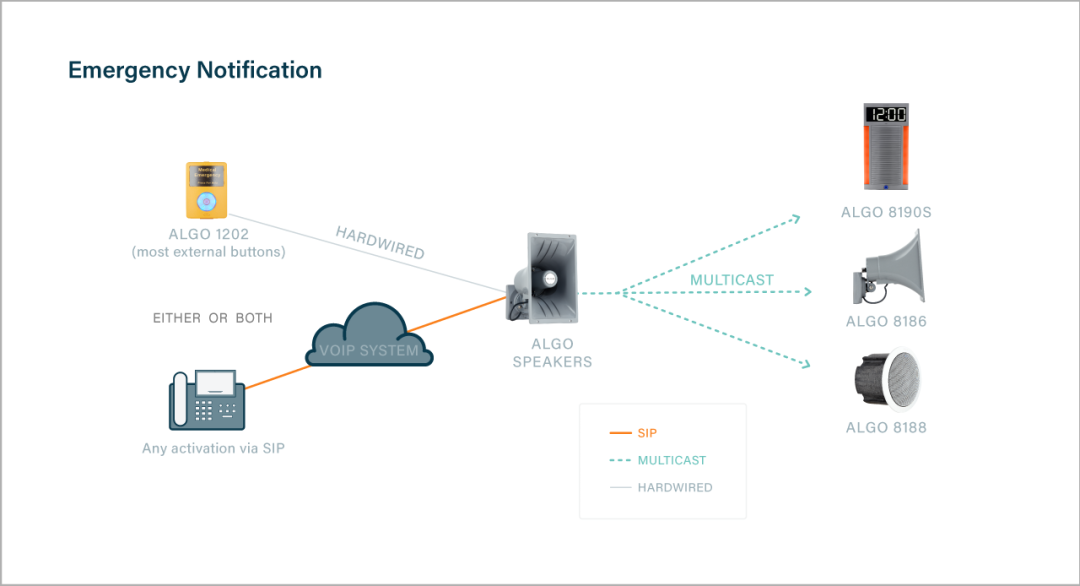
Common Deployments for Algo 8186 SIP Horn Speakers
Together with the Algo 8301 SIP Paging Adapter & Scheduler, a public address (PA) system requiring multiple zones with scheduled bells / announcements can be easily configured and synchronized with IP clocks using the 8186 and other Algo IP speakers.
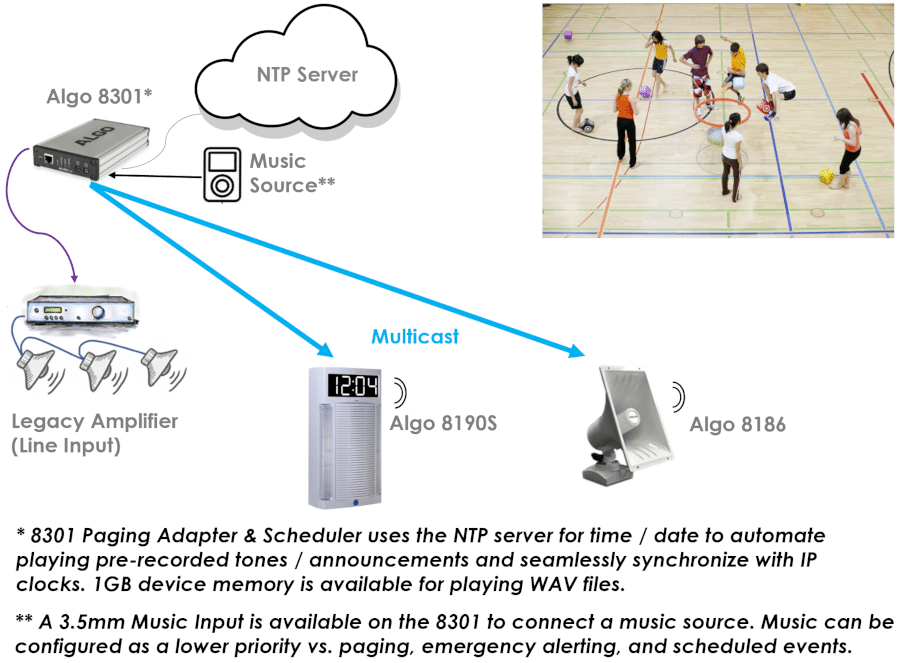
If desired, the 8301 IP paging adapter can also provide audio to a legacy analog paging system via its line-level output, and simultaneously multicast this audio to additional Algo IP endpoints.
To sum up, the 8186 is a self-amplified SIP horn speaker. Therefore no separate amplifier is required. The endpoint is powered via PoE (IEEE 802.3af). A mounting plate is included for easy installation to a wall or ceiling. The horn can also be fitted to a standard double gang box if running conduit to the speaker. The product is CSA/UL, FCC and CE certified.
Benefits of the PoE Algo SIP Horn Speaker
- Excellent Wideband audio clarity and intelligibility.
- IPX6 rated and suitable for outdoor and wet environments when properly installed with included mounting gaskets.
- Three-axis rotation for the widest range of vertical and horizontal adjustments – wall or ceiling mount.
- Network managed and supervised SIP and multicast endpoint.
- PoE (IEEE 802.3af) eliminates the need for local power supply and simplifies wiring infrastructure and management.
- Eliminates narrowband FXS port or ATA.
- Multi-functional IP speaker for voice paging, emergency notification, and ring alert. Easily integrate with the 8301 SIP Paging Adapter & Scheduler for automatically playing tones and/or announcements for scheduled events.
.
InformaCast Compliant IP Speaker
Algo InformaCast IP endpoints are fully compliant to register seamlessly with Singlewire InformaCast for emergency notification and public address.
The Algo 8186 SIP Horn Speaker is also sold as the Algo 8186-IC InformaCast SIP Horn Speaker, a fully InformaCast Compliant endpoint for voice paging, emergency alerting, and loud ringing applications. The speaker is also a fully compliant 3rd party SIP endpoint. As a result, the Algo 8186-IC InformaCast SIP Horn Speaker is compatible with most hosted / cloud and premise-based VoIP telephone systems.
The 8186-IC together with other InformaCast endpoints are scalable to meet the needs of any size project. Algo IP InformaCast compliant endpoints support multicast send or receive. As a result, many Algo IP endpoint can be deployed to cover any size building, campus, or enterprise. There is no limit to the number of devices part of a multicast, and a minimum of network traffic activity is utilized.
All features and specifications of the Algo 8186 SIP Horn Speaker remain in the Algo 8186-IC InformaCast SIP Horn Speaker.











